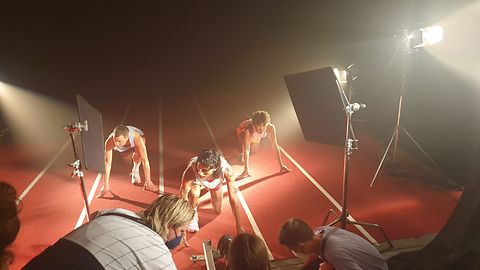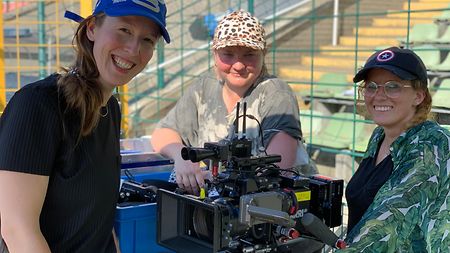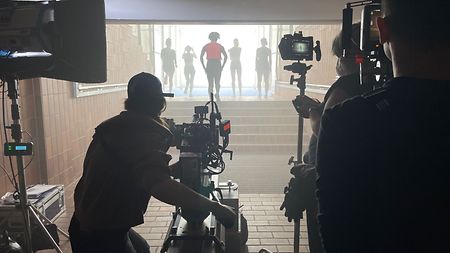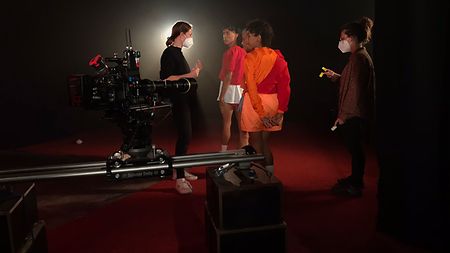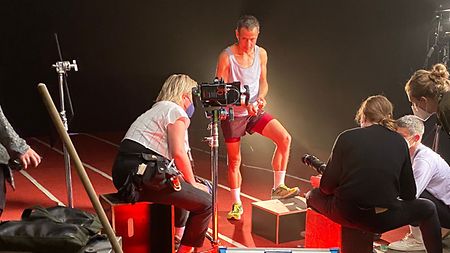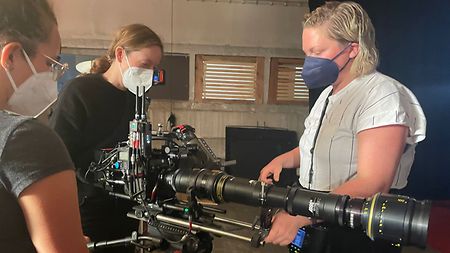Director Julia Fuhr Mann's “Life is not a competition, but I am winning” is one of three film projects to win the Franz Kraus Production Award 2021. With this award ARRI Rental supports graduation films with particularly strong camera concepts proposed by students of Munich's HFF film school. The winner receives a grant of up to €50,000 towards camera, lighting, and grip equipment. In its first year, the award attracted so many high-quality submissions that three projects were chosen to share the prize. Fuhr Mann's film investigates binary gender in the context of Olympic running disciplines, casts a spotlight on their queer-feminist potential, and proposes a poetically radical vision for a future that transcends gender categories. We spoke with DP Caroline Spreitzenbart about the film and how it came to be.
Why did you want to make a film on this topic?
The gender dualism that is still largely accepted as immutable in today's society often determines our life paths and how we interact with each other. What is defined on the birth certificate comes to a head in the sports stadium: according to rigid rules, one is assigned to binary categories, from which national heroes are chosen. As a passionate queer athlete and sports enthusiast, director Julia Fuhr Mann wanted to examine those rigid structures and together we wanted to make this rigidity bend – not just cinematically!
How did you go about that?
We accompanied present-day athletes in Germany and traveled with a fictive queer runner’s crew through archive material to the present day, so we can watch top athletes from the past like Wilma Rudolph and Stella Walsh compete. We visited historic Olympic venues where we created a utopian conceptualization of a new age beyond rigid gender stereotypes.
You used the ARRI ALEXA Mini to make the film. Why?
It was important for us to have a versatile camera body that was handy and yet high-performance. It had to be good for working intuitively and record ARRIRAW.
The film has three levels: fictional, documentary, and archive. How did that impact your choice of equipment?
It was really important to keep a unified look and feel throughout the movie, so ARRIRAW was a must, because it gave me more creative flexibility when it came to lighting and grading. I also elected to use lenses with a strong character, so as to be able to integrate elements from the black-and-white archive material into the other cinematic levels. On the fictional level I worked with Bausch & Lomb Super Baltars, and I shot the documentary material with coated and uncoated Zeiss High Speed lenses.
How did you design the look of the documentary passages?
We kept it fairly still and restrained. The framing was the main design element and reflected the protagonists’ personal stories. We worked a lot without artificial lighting structures and with tripods, Hi-Hats and rostrums. We really wanted to maintain atmospheric, cinematic storytelling throughout, not classical TV images. During the shoot we were pleasantly surprised by wonderful, natural lighting moods that gave the images that little something extra. One time a sandstorm came up out of nowhere. It gave us an extraordinary light and color that lent a very special background to the protagonists' world.
What was important to you in the fictional scenes?
It was essential to us that we did not direct the protagonists in front of the camera in a typical manner, but instead staged the protagonists and each scene’s content visually, using all the camera and lighting means at our disposal. We exploited various different perspectives with the Steadicam, drone, jib arm, and slider. The Century S 2000 MK II Periscope and Skater Scope helped us, visualizing a different viewpoint and sense of motion through the lens. We decided individually for each scene which filters and special lenses we would use, and how the lighting would underline the scene's purpose. In two sequences we mixed the documentary and fictional layers together, combining the technical and aesthetic elements accordingly.
What was your lighting concept?
Colored light is a key element in this film. We wanted it to be tangible, with haze and flares to outshine and dissolve hard contours, and to signify the degree of reality in the scenes. With show LUTs and lenses, gaffer Janne Ebel and I worked out a synergy between available light and a utopian lighting look. We wanted to generate a utopian atmosphere and a "docufiction" character, while at the same time upholding a balance with the documentary aspect.
We worked a lot with sunlight, using mirrors and butterflies. In some places, for instance in the Jahnstadion, we covered up the sun entirely with a 20x20 and then directed it into the scene in the desired directions via mirrors. With the harsh light of the ARRI M40s we wanted to create two suns to amplify the feelings of emotion and heroism, while at the same time evoking a radiance from the costume and skin using the red glow from the ARRI SkyPanel.
In the Mommsenstadion we complemented the stadium lighting with filtered Dino lights, bathing the running track in our own colors. We topped it all off by programming our own lighting animation on the roof of the Berlin Olympic Stadium. It was quite spectacular to "redesign" the stadiums by the way we set up the lighting and camera.
How was the support that you received from ARRI Rental?
Because every fictional scene had a different artistic design, we had to test the filters and lenses both before and during the various shoots. ARRI Rental enabled me to extensively test analog and digital cameras to find the best one for our needs, from Super 8 and 16 mm through to digital Super 35 and ALEXA LF. Manfred Jahn also proposed special lenses for extreme perspectives. During the test shoot, ARRI Rental made the excellent suggestion of filming on ARRIRAW. Without their help with the hardware and setup we would not have been able to get it done in the short time we had. I received a lot of support all round and was given the freedom to try various things out.
How important was ARRI Rental's technical support during the shoot?
Philip Schittko and Basti Prützmann were a fantastic help. The shooting conditions were constantly changing, and we always had to have the right equipment on hand. Once we had finished the fictional parts, we continued with the documentary part. The challenge was to not lose any technical or visual atmosphere or quality, and that required a lot of flexibility from all of us, in particular from ARRI Rental. It was a great collaboration. Without their support it would have been a completely different film.
How was it to realize a project with mainly women?
From the very start the idea was to ask mainly women and queer filmmakers to collaborate with us on the project, especially for the camera and lighting team. We wanted the story we were telling in the film to also bear the mark of who was directly behind the camera. And the collaboration was just as good with all the men who were involved throughout the project. From a language perspective we jumped between English, German, and Spanish. The main thing for us was for it to be a proactive, inclusive, and of course creative cooperation!
How difficult was it to find the people you wanted, especially given the general shortage of available crews?
Our inquiries for interested team members were passed around our personal networks. We made some new contacts, for instance with great people for the lighting and camera team. There are loads of highly talented and motivated women and queer filmmakers out there, and I am ecstatic that we were able to put together such an outstanding team!
